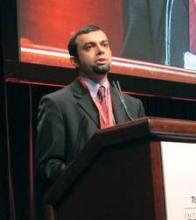HONOLULU – Just 1% of patients experienced a non-ST-elevation myocardial infarction following carotid-artery stenting or endarterectomy in a retrospective, nationally representative analysis of more than 1 million patients.
When it did occur, however, NSTEMI significantly increased periprocedural neurologic and cardiac complications, inpatient mortality, disability, and resource utilization – adding on average a full 10 days to hospital length of stay and nearly $85,000 in hospital charges, Dr. Amir Khan said during a plenary session at the International Stroke Conference. Dr. Khan is scheduled to present the study results at the annual meeting of the American Academy of Neurology in San Diego on March 20.
He observed that postoperative evaluation for MI varied in the data set, as it does nationally, but that post hoc analyses from the POISE (Perioperative Ischemic Evaluation) trial revealed that 65% of patients with an MI after noncardiac surgery did not have ischemic symptoms (Ann. Intern. Med. 2011;154:523-8).
"So, we know that hospitals that don’t have active surveillance regimens for non-STEMI will miss a fair amount of this," said Dr. Khan, an endovascular surgical neuroradiology fellow at the University of Minnesota in Minneapolis.
The majority of perioperative MI is NSTEMI. While few studies have parsed out MI types, the SAPPHIRE (Stenting and Angioplasty with Protection in Patients at High Risk for Endarterectomy) trial showed that 80% of carotid endarterectomy (CEA) patients with periprocedural MI and all carotid angioplasty or stenting (CAS) patients with periprocedural MI were NSTEMI (N. Engl. J. Med. 2004;351:1493-1501).
In an effort to assess the frequency of periprocedural NSTEMI following CEA or CAS in practice and its relationship with outcomes, the researchers used data from the Nationwide Inpatient Sample for all adult patients who underwent CEA or CAS from 2002 to 2009. From this, hospital-weighted national estimates were generated using Healthcare Utilization Project algorithms.
Overall, 11,341 patients (1%) experienced an NSTEMI and 1,072,347 did not; 92% of all patients underwent endarterectomy.
Age, gender, and racial distribution were roughly similar between groups, although patients with NSTEMI had significantly higher baseline rates of atrial fibrillation (24% vs. 8%), heart failure (24% vs. 6.5%) and chronic renal insufficiency (16% vs. 5%), Dr. Khan noted.
In terms of health care usage, rates were slightly higher among NSTEMI patients for inpatient diagnostic cerebral angiography (19% vs. 13.5%), gastrostomy (3% vs. 0.4%), and postprocedure mechanical ventilation (0.5% vs. 0.3%; all P less than .0001).
Blood transfusions were conspicuously higher in those with NSTEMI at 20% vs. 3% in those without, he said. The average length of stay also jumped with NSTEMI from 2.8 days to 12.2 days, pushing hospital charges from an average of $29,160 to $113,317 (all P less than .0001).
Neurologic complications were seen in 6% of patients with NSTEMI vs. 1.4% without, while cardiac complications occurred in 31% vs. 1.5%. In addition, 31% of NSTEMI patients were moderately or severely disabled at discharge vs. just 6% without NSTEMI (all P less than .0001), Dr. Khan reported at the conference, sponsored by the American Heart Association.
In-hospital mortality was 6% in the NSTEMI group and 0.5% in the group without. The composite endpoint of cardiac or neurologic complication and/or death was reached by 38% vs. 3% (both P less than .0001).
When these numbers were plugged into a multivariate analysis that adjusted for age, gender, and comorbidities, the odds ratios for patients with NSTEMI were 3.6 for neurologic complications, 23.2 for cardiac complications, 8.6 for in-hospital mortality, 14.6 for the composite end point, and 5.5 for moderate to severe disability (all P less than .0001), he said.
During a discussion following the presentation, an audience member expressed concern about the complication rates, rising to say, "Often we make decisions about stroke treatment based only on what’s good for the brain. Well there’s no point in making the brain better if the person can have a heart attack and die of some other complications, and I really think this [study] emphasizes that."
Dr. Khan replied, "I totally agree and I think that is one of the take-home messages here ... "
Dr. Khan and his coauthors reported no disclosures.

